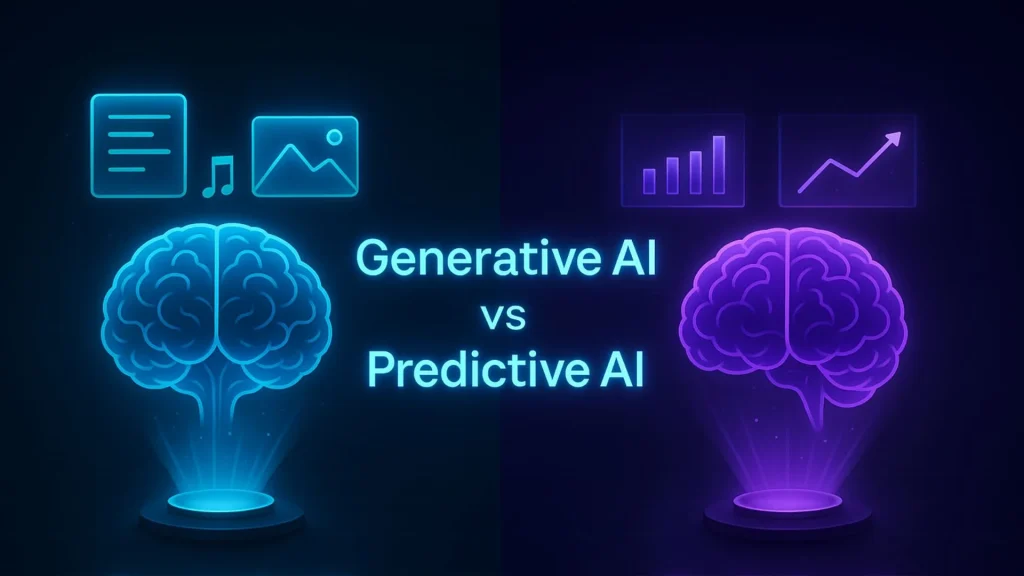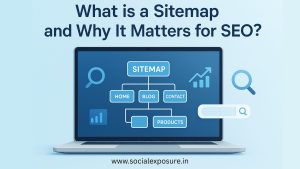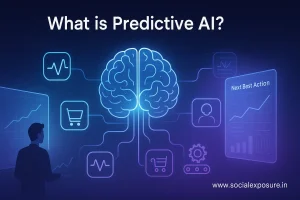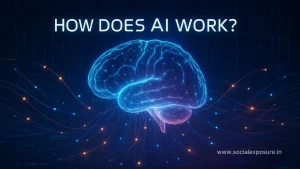Artificial intelligence is changing how we build, predict, and create. But not every AI system does the same thing. While generative AI creates content, images, or code, predictive AI focuses on patterns, forecasting, and smart suggestions.
If you’re a business owner, developer, student, or just curious about tech, this blog will help you understand the difference and know which one fits your needs.
Social Exposure, known as the Best Digital Marketing Agency, believes that clarity drives better choices. So we’ve built this guide using trusted research and real-world use cases.
According to a 2023 report by McKinsey, generative AI could contribute up to $4.4 trillion annually to the global economy, especially in customer service, marketing, R&D, and software. Meanwhile, predictive AI models are already powering tools that handle recommendations, fraud detection, and decision automation.
You don’t need a tech background to follow. We’ll keep it simple and useful just the way it should be.
What is Generative AI?
Imagine an intelligent tool that can write a story, design an image, compose a tune, or even code a simple webpage all based on what it has learned from data. That’s what generative AI does.
At its core, generative AI uses existing information to create new content. It learns from vast sets of data like books, articles, audio files, and visuals. Then it uses that learning to produce original output such as text, images, or audio that mimics human creativity. The result is called AI-generated content, and you’ve likely seen it in action through chatbots, voice assistants, or image creation tools.
Whether it’s helping writers with drafts or assisting designers with visual ideas, generative AI plays a growing role in how digital content gets created today.
How Generative AI Works?
Think of it like this: You give an input (a question or a prompt), the AI model processes it, and you receive a new piece of content in return. That’s the basic structure behind these tools input > model > output.
These models rely on what are known as large language models or LLMs. One of the most well-known is GPT, short for Generative Pre-trained Transformer. It’s designed to understand patterns in language and generate coherent, context-aware responses.
These systems are trained on billions of words from public datasets, allowing them to recognize language structure, intent, and even tone. The more refined the training data, the better the output becomes.
A growing number of content generation tools are using these models to automate tasks like writing emails, generating headlines, or drafting reports. Some are even being used in industries like film, gaming, healthcare, and product design wherever creative output is needed quickly and at scale.
According to Stanford’s April 2024 AI Index, companies spent as much as $191 million to train frontier models like Gemini Ultra, while GPT‑4 alone required around $78 million in compute. These numbers highlight how generative AI is not just advancing in capability it’s also becoming a major investment for organizations serious about innovation.
What is Predictive AI?
Predictive AI is a branch of artificial intelligence that studies past data to anticipate future outcomes. By analyzing patterns in historical information, it helps systems forecast trends, behaviors, and events with measurable accuracy. These models rely on data prediction techniques to make decisions that are based on probability, not guesswork.
How Predictive AI Works?
Behind the scenes, predictive AI models are trained on historical data to recognize patterns and trends. These models use that learning to make informed guesses about what might happen next. Think of it as a tool that doesn’t create new content, but instead uses existing information to make smarter forecasts.
The process begins with large datasets such as customer purchases, browsing behavior, or sensor data which are cleaned and fed into models. These models apply forecasting algorithms and data prediction techniques to identify relationships in the data. The result? An output that helps businesses and systems act with foresight.
You’ve already seen predictive AI in action. It powers the systems behind product recommendations, fraud alerts, credit scoring, and even health risk assessments. For example, Amazon uses predictive analytics to suggest what you might want to buy next, based on your previous purchases and browsing history. In healthcare, predictive tools help doctors estimate patient risk based on past symptoms and outcomes.
According to Statista, the global predictive analytics market was valued at approximately $12.49 billion in 2022 and is expected to grow to around $38.03 billion by 2028, showing strong adoption across sectors such as finance, healthcare, and supply chain management.
While generative AI builds something new, predictive AI helps you prepare for what’s next using data to cut uncertainty and make decisions with more confidence.
Key Differences Between Generative AI and Predictive AI
While both models fall under the broader field of artificial intelligence, their roles, output, and use cases are quite different. One is built to create, the other to predict. Understanding the difference between generative AI and predictive AI is essential for choosing the right tool for the job.
Let’s break it down clearly:
Feature | Generative AI | Predictive AI |
Purpose | Create new data using learned patterns | Predict outcomes based on past data |
Output | Text, images, audio, code | Numerical or categorical predictions |
Model Type | Transformer-based models like large language models | Regression, decision trees, classification techniques |
Examples | ChatGPT, DALL·E, Midjourney | Netflix recommendations, fraud detection, sales forecasting |
Risk and Limitations | May produce biased or factually incorrect output | Relies heavily on clean, historical data; struggles with new or rare scenarios |
Each type of AI model training involves different objectives. While generative AI focuses on content creation, predictive AI is about recognizing trends and forecasting the next likely outcome.
Real-World Use Cases of Generative and Predictive Ai
Understanding where these tools fit into actual workflows can make their differences more practical. Both have value, but their strengths show up in different situations. Below are examples of how each is used across industries.
Where You Might Use Generative AI?
When you need fresh content, design ideas, or natural language output, generative AI steps in. It builds something new from what it has already learned.
Common use cases include:
- Content creation using AI: Drafting blog posts, product descriptions, social media captions
- Image and design generation: Creating visuals for ads, mockups, or branded assets
- Chatbot development: Powering conversation flow for websites or mobile apps
- Customer support automation: Auto-generating responses for common service queries
Real-world example: Canva’s Magic Write feature uses generative AI to help users draft copy inside design templates. Similarly, Jasper AI helps marketing teams generate first-draft content.
Where Predictive AI Fits Better?
If the goal is to understand trends, forecast activity, or personalize at scale, predictive AI is more effective. It works silently in the background, turning patterns into actions.
Common use cases include:
- Predictive analytics in ecommerce: Forecasting product demand based on seasonal data
- Fraud detection: Spotting unusual activity in banking or online payments
- Visitor behavior prediction: Analyzing who’s likely to convert on a landing page
- Ad targeting: Optimizing campaigns based on past user interactions
Real-world example: Amazon’s product recommendation engine uses predictive AI models trained on user behavior to suggest what customers are likely to purchase next. In finance, PayPal applies similar models to flag potential fraud in real time.
These use cases of generative and predictive AI help businesses cut costs, improve accuracy, and personalize experiences but the best outcomes come from knowing which type of intelligence to apply in each situation.
Which One Should You Use?
Choosing between predictive AI and generative AI depends on what you need to solve. These tools are built for different purposes, and your goal helps decide which one fits better.
Let’s break it down by use case and audience type.
For Business Owners and Marketers
If your focus is creative output or customer engagement, generative AI can be a game-changer. When the goal shifts to decision-making based on data, predictive AI becomes more valuable.
Use generative AI if:
- Your team needs help producing content faster
- You want to scale ad copy, blog writing, or visuals
- You’re experimenting with chatbot responses or automated messaging
Use predictive AI if:
- You rely on machine learning models to forecast sales or customer churn
- You’re optimizing inventory or campaign timing
- You want to personalize user experiences using past behavior
The right pick depends on the challenge. If you’re creating, go generative. If you’re analyzing, choose predictive.
For Students, Developers, and General Users
Getting started with AI can feel overwhelming, but knowing where to begin makes a difference.
Start with predictive AI if:
- You want to understand how systems learn from data
- You’re curious about analytics, trends, and outcome probabilities
- You need a foundation in structured data flow
Move into generative AI once:
- You’re familiar with how models process input and generate results
- You’ve grasped the basics of data prediction techniques and want to explore creative automation
- You’re ready to experiment with tools like ChatGPT or DALL·E
Knowing when to use predictive AI vs generative AI gives you a practical edge. You can work smarter by applying the right system at the right time, whether for personal learning or solving real business problems.
Conclusion
Understanding the difference between predictive and generative AI helps you use the right approach for the right task. One predicts what’s likely to happen, the other creates something new based on what it has learned. Both are useful. Knowing when to apply them is what makes the real difference.
Whether you’re exploring AI decision making for your next project or simply learning how these models work, the tools are ready and now, so are you.
We’ll cover more specific applications in future blogs, including industry-focused use cases and tools for developers and marketers. Until then, keep experimenting and keep asking the right questions.
This guide is brought to you by Social Exposure, the Best Digital Marketing Agency for businesses that want to grow smart and stay ahead.
Frequently Asked Questions
Is ChatGPT a generative AI model?
Yes. ChatGPT is a type of generative AI trained to understand and respond using natural language. It generates original responses based on input, making it useful for conversation, content creation, and task automation.
Can predictive AI be used for marketing campaigns?
Absolutely. Businesses use predictive AI models to forecast campaign performance, segment audiences, and optimize timing. These tools help marketers make informed decisions by analyzing past engagement and purchase behavior.
Are generative AI tools safe to use?
Most generative AI tools are safe for everyday use, especially when used within ethical and legal limits. Still, users should monitor for biased or misleading output, especially in sensitive applications like healthcare or legal documentation.
Can a model be both predictive and generative?
Some models are designed with hybrid capabilities. For example, a chatbot might use generative AI to create messages and predictive AI to decide when and how to respond. However, most systems specialize in one task for better performance.
What skills are needed to work with predictive AI?
Working with predictive AI models usually involves knowledge of machine learning, statistics, and data preprocessing. Skills in tools like Python, SQL, and platforms like TensorFlow or Scikit-learn are also valuable for technical users.
How do businesses choose between these two types of AI?
It comes down to intent. If the goal is to create content or automate communication, generative AI is the better fit. If the focus is forecasting trends or understanding user behavior, predictive AI is more effective.
Will generative AI replace predictive AI?
Not likely. Both serve different purposes. Businesses often use them together predictive AI to understand what’s happening and generative AI to act on that insight. Integration, not replacement, is the more common approach.






